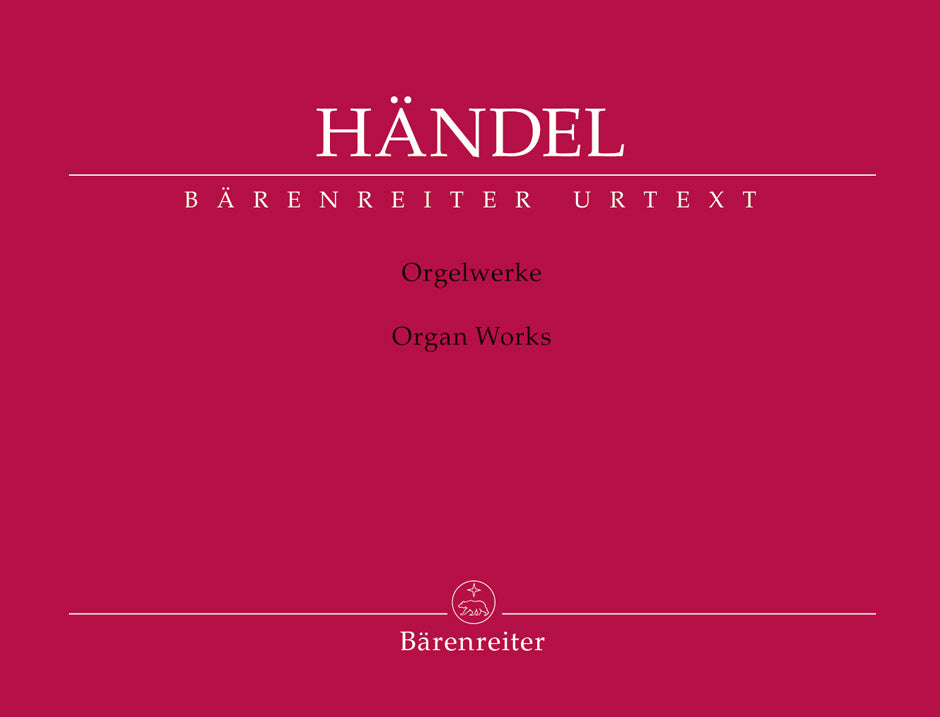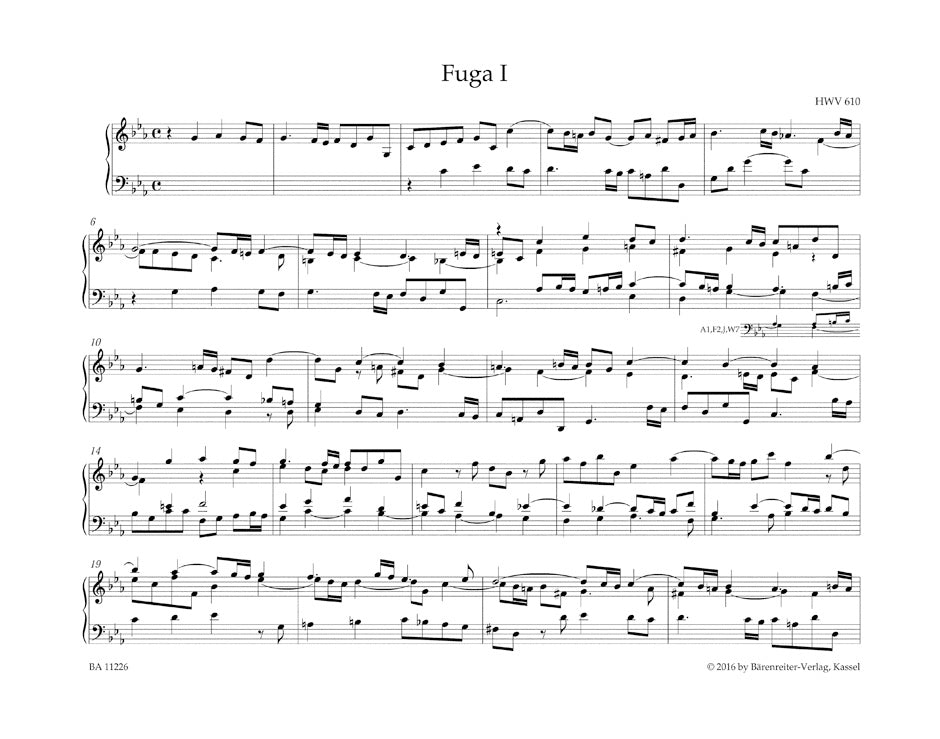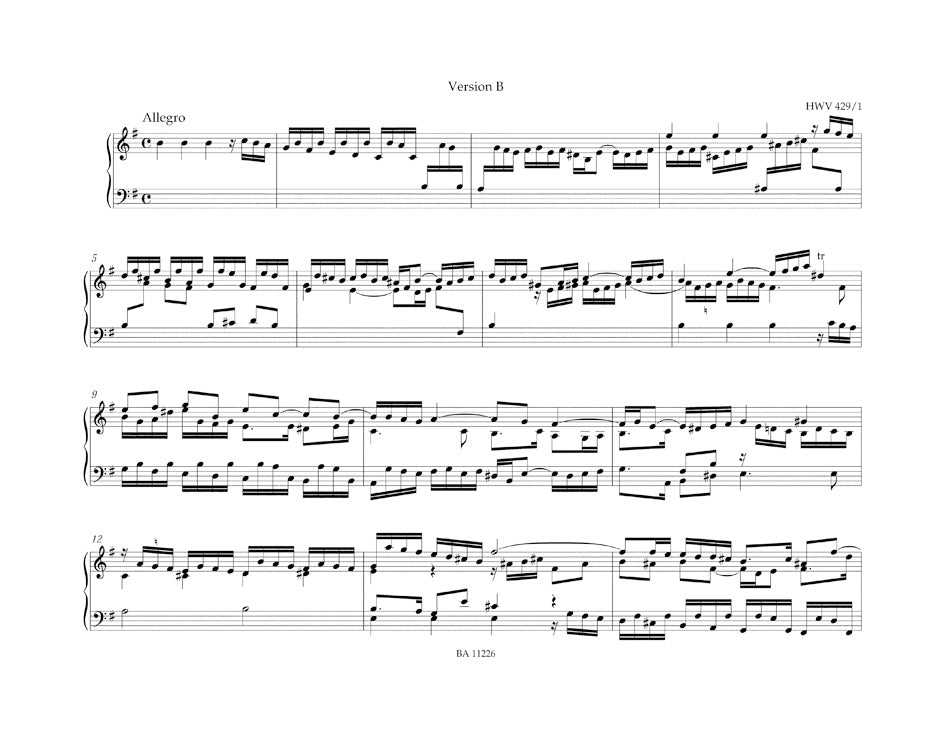Handel: Organ Works
In stock and typically ships within 1 business day.
- Composer: George Frideric Handel (1685-1759)
- Editor: Siegbert Rampe
- Instrumentation: Organ
- ISMN:
- Size: 12.0 x 9.4 inches
- Pages: 49
- Urtext / Critical Edition
Description
In terms of layout and musical text, this scholarly-critical performing edition of George Frideric Handel's Complete Organ Works is based on the complete edition volumes of the composer's keyboard music edited by Terence Best as part of the Halle Handel Edition (HHA).
The HHA Critical Commentary forms the basis of this edition, which however differs from the HHA volumes in two respects. Firstly, it gathers together, for the first time, all of Handel works for which it can be solidly argued that they were composed for the organ. The centre piece is a set of twelve handwritten fugues deriving directly from his immediate surroundings and published here, for the first time, as a unified cycle. Secondly, this edition presents plausible alternative readings from various sources in the main body of the music. in the HHA these readings, all of which definitely or presumably stem from the composer, are merely listed in the critical commentary.
Contents:
- Fugue I in C Minor., HWV 610
- Fugue II in G Minor, HWV 605
- Fugue III in B-flat Major, HWV 607
- Fugue IV in F Minor, HWV 433/2
- Fugue V in E Minor, HWV 429/1
- Fugue VI in G Major, HWV 606
- Fugue VII in D Minor, HWV 428/2
- Fugue VIII in A Minor, HWV 609
- Fugue IX in B Minor, HWV 608
- Fugue X in F-sharp Minor, HWV 431/3
- Fugue XI in F Major, HWV 427/4
- Fugue XII in F Major, HWV 611
- "Fugue in E Major", HWV 612
- "O the pleasure of the plains" in G Major, HWV 474 "- Jesu meine Freude" in G Minor, HWV 480
Publishers use a lot of words to describe what they sell, and we know it can be confusing. We've tried to be as clear as possible to make sure you get exactly what you are looking for. Below are descriptions of the terms that we use to describe the various formats that music often comes in.
Choral Score
A score for vocalists that only contains the vocal lines. The instrumental parts are not there for reference. Generally, cheaper than a vocal score and requires multiple copies for purchase.
Facsimile
Reproductions of the original hand-written scores from the composer.
Full Score
For ensemble music, this indicates that the edition contains all parts on a single system (there are not separate parts for each player). In larger ensembles, this is for the conductor.
Hardcover
Hardbound. Generally either linen-covered or half-leather.
Orchestral Parts
Similar to a wind set, this is a collection of parts. In the case of strings, the numbers listed are the number of copies included, though generally these are available individually (often with minimum quantities required).
Paperback
When publishers offer multiple bindings (e.g. hardcover) or study scores, this is the "standard" version. If you're planning to play the music, this is probably what you want.
Performance / Playing Score
A score of the music containing all parts on one system, intended for players to share. There are not separate parts for each player.
Set of Parts
For ensemble music, this indicates that there are separate individual parts for each player.
Solo Part with Piano Reduction
For solo pieces with orchestra, this is a version that contains a piano reduction of the orchestra parts. For piano pieces, two copies are typically needed for performance.
Study Score
A small (think choral size) copy of the complete score meant for studying, and not playing. They make great add-ons when learning concertos and small chamber works.
Vocal Score
A score prepared for vocalists that includes the piano/organ part or a reduction of the instrumental parts.
Wind Set
For orchestral music, this is a collection of wind and percussion parts. The specific quantities of each instrument are notated.
With Audio
In addition to the printed music, the edition contains recordings of the pieces. This may be an included CD, or access to files on the internet.
With / Without Fingering (Markings)
Some publishers prepare two copies - a pure Urtext edition that includes no fingering (or bowing) suggestions and a lightly edited version that includes a minimal number of editorial markings.





